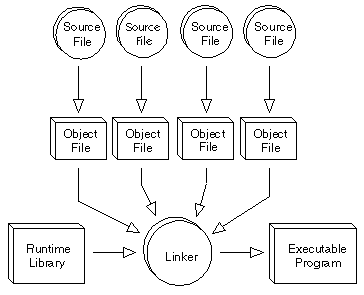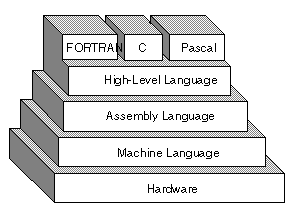2008. 4. 5. 12:56
@GSMC/서용덕: DMD Programming
setting up
unix 명령어
rm - 파일 지우기
mkdir - 디렉토리(폴더) 만들기
rmdir - 디렉토리(폴더) 지우기
module
Code design should include major algorithms, module definitions, file formats, and data structures. (96쪽)
The code would be broken up into modules. (98쪽)
그니까 대체 모듈이 뭐냐고~ 예전부터 애매모호하다.
In software, a module is a part of a program. Programs are composed of one or more independently developed modules that are not combined until the program is linked. A single module can contain one or several routines.
link
In programming, the term link refers to execution of a linker.

linker
Also called link editor and binder, a linker is a program that combines object modules to form an executable program. Many programming languages allow you to write different pieces of code, called modules, separately. This simplifies the programming task because you can break a large program into small, more manageable pieces. Eventually, though, you need to put all the modules together. This is the job of the linker.
In addition to combining modules, a linker also replaces symbolic addresses with real addresses. Therefore, you may need to link a program even if it contains only one module.
register (98쪽)
동아프라임:【컴퓨터】 레지스터 《CPU가 적은 양의 데이터나 처리하는 동안의 중간 결과를 일시적으로 저장하기 위해 사용하는 고속의 기억회로》
webopedia: A, special, high-speed storage area within the CPU. All data must be represented in a register before it can be processed. For example, if two numbers are to be multiplied, both numbers must be in registers, and the result is also placed in a register. (The register can contain the address of a memory location where data is stored rather than the actual data itself.)
The number of registers that a CPU has and the size of each (number of bits) help determine the power and speed of a CPU. For example a 32-bit CPU is one in which each register is 32 bits wide. Therefore, each CPU instruction can manipulate 32 bits of data.
Usually, the movement of data in and out of registers is completely transparent to users, and even to programmers. Only assembly language programs can manipulate registers. In high-level languages, the compiler is responsible for translating high-level operations into low-level operations that access registers.

메모리는 CPU 밖에 있고 레지스터는 CPU 안에 있는 것인가 보다.
Good communication is the key to good programming, and the more you can show someone the better. (100쪽)
compilation
unix 명령어 - make
make uses the modification dates of the files to determine whether or not a compile is necessary. Compilation creates an object file. (The modification date of the object file is later than the modification date of its source. If the source was modified after the object, make recompiles the object.) (103-104쪽)
Testing
One of the advantages of making a small working prototype is that we can isolate errors early. (104쪽)
Debugging
Run the program and keep putting in printf statements until you isolate the area in the program that contains the mistake.
Maintenance
Revisions
rand()
Generate random number
random.c http://fxr.watson.org/fxr/source/libkern/random.c
'@GSMC > 서용덕: DMD Programming' 카테고리의 다른 글
| week 6 review (0) | 2008.04.16 |
|---|---|
| [Steve Oualline] 8. More Control Statements (0) | 2008.04.06 |
| week 4 review (0) | 2008.03.27 |
| [Steve Ouallline] 6. Decision and Control Statements (0) | 2008.03.25 |
| week 3 review (0) | 2008.03.22 |
